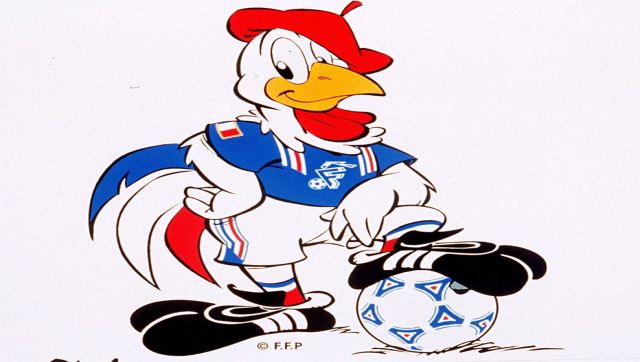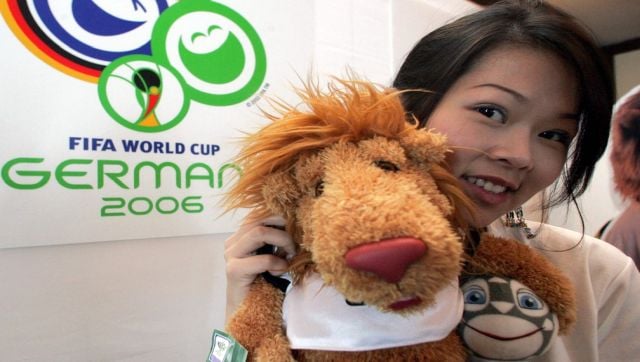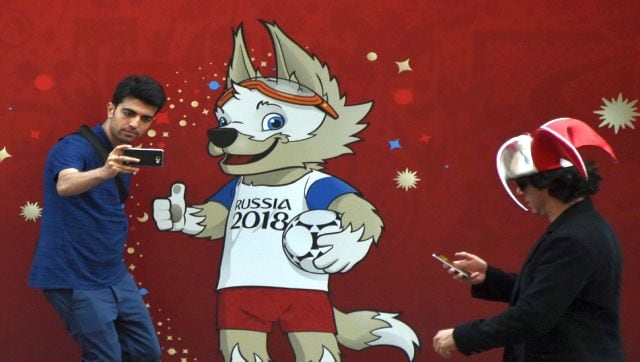Football fever has struck the world as FIFA World Cup 2022 begins. As the mega sporting event gets underway in Qatar amid several controversies , one constant sighting at the matches will be that of the mascot. This edition sees the introduction of the “adventurous, fun and curious” La’eeb, who resembles Casper — the friendly ghost, as the mascot for the 2022 World Cup in Qatar.
He's come from the mascot-verse full of energy and is ready to bring the joy of football to everyone!
— FIFA World Cup (@FIFAWorldCup) April 1, 2022
Introducing: La'eeb - the #FIFAWorldCup Qatar 2022 Official Mascot pic.twitter.com/RrEA6iS6t4
Revealed on 1 April, La’eeb, which means “super-skilled player” in Arabic, belongs to a parallel mascot-verse that is indescribable — everyone is invited to interpret what it looks like. During the unveiling, FIFA had said that La’eeb can be a “figment of your imagination”. “He is whoever a football fan wants him to be.” At first glance, La’eeb is a white floating ghutrah — a traditional headdress worn by men — with eyes, eyebrows and an open mouth. Though its unclear what he is, La’eeb’s goal is clearly to bring positive vibes to the tournament, with the motto “Now is All”.
**Also read: FIFA World Cup 2022 schedule: Fixtures, dates and timings in IST** As the games begin in this 22nd edition, let’s take a closer look at the history of FIFA World Cup mascots and what role they play at the tournament. What is a World Cup mascot? Before we take a look at past mascots, let’s understand what exactly is the mascot and what role does it achieve. FIFA World Cup mascots are a series of unique characters for each event and represent a characteristic of the host country, such as flora, fauna, or costume. The design is often characters targeted at children and coinciding with cartoon shows and merchandise. In fact, many of the memories of the editions gone by are connected to the mascot, which shows what a crucial role they play in the tournament. History of FIFA mascots La’eeb is the 15th mascot at the FIFA World Cups in its 92-year history. In fact, it was only during the 1966 World Cup in England that an official mascot was introduced for the event. Previously, during Sweden 1958 and Chile 1962 there are records of an attempt at a mascot although they were not recognised as the official one and therefore did not have the marketing impulse of FIFA to consolidate it in the collective imagination. It was then in 1966, when England was the host, that the event saw its first official mascot — World Cup Willie. Perhaps the most iconic mascot of the World Cups, this mascot was a lion, a symbol of the United Kingdom, wearing a Union Flag jersey with the words ‘World Cup. The mascot was designed by freelance children’s book illustrator Reg Hoye. According to reports, Hoye — along with fellow artist Richard Culley —had previously worked on illustrations for Enid Blyton’s Noddy books, as well as the BBC’s Dr Who and The Daleks. They were given a free hand on the design and the initial options included a sketch of a bulldog. Today, World Cup Willie is one of the most famous mascots in World Cup history and a search for World Cup Willie on any given day still turns up anything from 80 to 100 pieces of memorabilia. [caption id=“attachment_11668141” align=“alignnone” width=“640”] Graphic: Pranay Bhardwaj[/caption] In Mexico 1970, ‘Juanito’, a Mexican boy with a sombrero in the host colours was the mascot. He provided a fittingly vibrant mascot for the first World Cup broadcast in colour. The character represented Mexico’s culture and their relation with football. The following World Cup, held in West Germany, saw two boys — Tip and Tap — in the hosts country’s white shirts, one emblazoned with the letters WM (Weltmeisterschaft, German for World Cup) and the other with the number 74.
**Also read: FIFA 2022: No song will come close to replicating the magic of Shakira's Waka Waka** The theme of a young boy as the mascot continued in 1978 in Argentina. The mascot, named Gauchito, was a young boy wearing a hat carrying the words ‘ARGENTINA 78’ and a handkerchief and carried a whip; typical gaucho symbols. Spain in 1982 took what is perhaps the biggest step away from the usual norm for the design of the World Cup mascots. They took a fruity route with Naranjito taking the form of an orange. Again, he was decked in his national team’s kit and also wore an especially wide grin. It seems that after the fruit option, Mexico, who once again played host in 1986, said ‘why not a vegetable’. In 1986, inspired by the Jalapeno Pepper, an integral part of their cuisine, the mascot named Pique was unveiled. ‘Pique’ is derived from Picante (Spanish for spicy). Interestingly, Pique donned the sombrero of ‘Juanito’. [caption id=“attachment_11668391” align=“alignnone” width=“640”]
The official mascot “Pique” of the 1986 FIFA World Cup in Mexico. AFP[/caption] In 1990, Italy introduced to the world one of the most bizarre mascots the world has ever seen. Ciao is a stick figure whose body bore the colours of the Italian tricolour topped off with a football for a head. The mascot was chosen to represent the amalgamation of sport, art and architecture in the Italian culture. Another revolutionary change in mascots came in USA 1994 when the American public voted for their tournament’s mascot. Their choice was Striker, a dog kitted out in the hosts’ red white and blue, with the competition logo displayed on his shirt. This mascot was designed by the world-famous Warner Bros studio. He was intended to represent the joy and energy that the game brings with it. In 1998, France opted to use a national emblem as part of its mascot. The mascot for this World Cup was Footix, a cockerel (a young male chicken), one of the national symbols of France. Footix wore a national jersey with the words ‘FRANCE 98’ written on them and a football in his left hand. [caption id=“attachment_11668431” align=“alignnone” width=“640”]
 France decided to choose Fabrice Pialot’s cockerel as their mascot for the 1998 World Cup. The bird can also be seen on the current crest of the Les Bleus. AFP[/caption] The first World Cup of this century, hosted by Japan and South Korea, saw for the first time three mascots. Enter Ato, Kaz and Niks — computer-generated images in orange, blue and purple. The story behind the trio was that Ato was a coach and Kaz and Nik were his students. For the 2006 World Cup in Germany, a lion was selected as the official mascot. Named Goleo, he wore the German national jersey worn by the national team between the 1950s and 1970s. His sidekick was Pille, who was a talking football. The name Galeo is an amalgamation of Goal and Leo. While it was criticised then for choosing the lion, as many wanted the eagle, which is on the German coat of arms, FIFA.com users recently voted Goleo VI and Pille as their favourite mascots of the past five World Cups. [caption id=“attachment_11668461” align=“alignnone” width=“640”]
France decided to choose Fabrice Pialot’s cockerel as their mascot for the 1998 World Cup. The bird can also be seen on the current crest of the Les Bleus. AFP[/caption] The first World Cup of this century, hosted by Japan and South Korea, saw for the first time three mascots. Enter Ato, Kaz and Niks — computer-generated images in orange, blue and purple. The story behind the trio was that Ato was a coach and Kaz and Nik were his students. For the 2006 World Cup in Germany, a lion was selected as the official mascot. Named Goleo, he wore the German national jersey worn by the national team between the 1950s and 1970s. His sidekick was Pille, who was a talking football. The name Galeo is an amalgamation of Goal and Leo. While it was criticised then for choosing the lion, as many wanted the eagle, which is on the German coat of arms, FIFA.com users recently voted Goleo VI and Pille as their favourite mascots of the past five World Cups. [caption id=“attachment_11668461” align=“alignnone” width=“640”] A fan holds the FIFA World Cup Germany 2006 official Mascot “Goleo”. File image/AFP[/caption] Inspired by leopards, a common feature in South Africa, ‘Zakumi’ was the mascot for the 2010 World Cup. The ‘ZA’ in its name stood for South Africa, while ‘Kumi’ meant 10 in various African languages. Zakumi also sported green and gold colours, an ode to the sports kits of the African nation. The 2014 World Cup in Brazil was one of the most vibrant in recent history. The whole country came together to show off its beauty and love for life. This was translated into the design of its mascot, a three-banded armadillo named Fuleco. The name Fuleco is a fusion of the words ‘futebol’ and ‘ecologia’. The shell that protects him has evolved to represent the natural beauty of Brazil he is so committed to protecting. The blue tones represent the sky and clear waters in and around Brazil. [caption id=“attachment_11668491” align=“alignnone” width=“640”]
A fan holds the FIFA World Cup Germany 2006 official Mascot “Goleo”. File image/AFP[/caption] Inspired by leopards, a common feature in South Africa, ‘Zakumi’ was the mascot for the 2010 World Cup. The ‘ZA’ in its name stood for South Africa, while ‘Kumi’ meant 10 in various African languages. Zakumi also sported green and gold colours, an ode to the sports kits of the African nation. The 2014 World Cup in Brazil was one of the most vibrant in recent history. The whole country came together to show off its beauty and love for life. This was translated into the design of its mascot, a three-banded armadillo named Fuleco. The name Fuleco is a fusion of the words ‘futebol’ and ‘ecologia’. The shell that protects him has evolved to represent the natural beauty of Brazil he is so committed to protecting. The blue tones represent the sky and clear waters in and around Brazil. [caption id=“attachment_11668491” align=“alignnone” width=“640”] Tourists and fans walk by a poster with the official tournament mascot Zabivaka as part of the 2018 FIFA World Cup Russia Football Park on Red Square in Moscow. File image/AFP[/caption] Finally, came Zabivaka during the 2018 Russia World Cup. A wolf who radiates fun, charm and confidence, the name of the mascot meant “the one who scores”. Developed by student designer Ekaterina Bocharova, Zabivaka was described as “charming, confident and social and always dreamed of becoming a football star. He is a fair player, values his team members, respects his opponents, and plays with skill and purpose. He is always fun to be around and, as the joker in the pack, knows how to make others laugh.” With inputs from agencies Read all the Latest News , Trending News , Cricket News , Bollywood News , India News and Entertainment News here. Follow us on
Facebook,
Twitter and
Instagram.
Tourists and fans walk by a poster with the official tournament mascot Zabivaka as part of the 2018 FIFA World Cup Russia Football Park on Red Square in Moscow. File image/AFP[/caption] Finally, came Zabivaka during the 2018 Russia World Cup. A wolf who radiates fun, charm and confidence, the name of the mascot meant “the one who scores”. Developed by student designer Ekaterina Bocharova, Zabivaka was described as “charming, confident and social and always dreamed of becoming a football star. He is a fair player, values his team members, respects his opponents, and plays with skill and purpose. He is always fun to be around and, as the joker in the pack, knows how to make others laugh.” With inputs from agencies Read all the Latest News , Trending News , Cricket News , Bollywood News , India News and Entertainment News here. Follow us on
Facebook,
Twitter and
Instagram.


)

)
)
)
)
)
)
)
)



